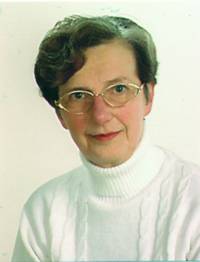


Barbara Sandner (née Meinke, *1937) was born in Stralsund. There, she attended elementary school until the 8th grade in 1952 and high school until her Abitur (university entrance qualification) in 1956. Starting in the 7th grade, her chemistry teacher sparked Barbara's interest in the subject. Her parents, who worked in business, supported her and bought her a chemistry textbook, which was used to train laboratory technicians and chemical specialists in vocational schools – textbooks for elementary and high schools were nonexistent in the postwar period.
At high school, the chemistry teacher offered an afternoon Working Group with experimental opportunities, which Barbara participated in. It's therefore not surprising that she—the only one in her year—applied to study chemistry at Humboldt University in Berlin. She was rejected because her political views, along with her Cs in history and contemporary studies, in contrast to her A's and B's in all other subjects, raised doubts.
Her second application was to the Leuna-Merseburg University of Chemistry, founded on September 1, 1954. Representatives of the university came to Rostock for an interview, which was successful. Barbara began her studies in Merseburg in October 1956.
After passing her intermediate diploma and completing her undergraduate studies, her main interest turned to polymer chemistry. She attended an introductory lecture and the lecture "Man-Made Fibers," the latter given by Hermann Klare (1909–2003). He was deputy director of the Institute for Fiber Research at the Academy of Sciences in Teltow-Seehof. Supervised by Joachim Ulbricht (1924–2017), Barbara completed her diploma thesis there in 1960/61, having heard only positive things from other students.
After her thesis was accepted and she passed her diploma examination, she received a doctoral position as a research assistant at the institute in Teltow-Seehof. In Ulbricht's working group, she completed her dissertation, "The Influence of Impurities on the Solution Polymerization of Acrylonitrile with Special Consideration of Unsaturated Compounds." She submitted it to the Merseburg University of Technology in 1965 and defended it there at the end of 1965.
During her doctoral studies, she met and married her husband, also a chemist. Their daughter was born in 1964. Because there weren't enough daycare and kindergarten places in the 1960s, her grandmother came to Teltow to care for the baby. The Sandners weren't able to get the larger apartment they needed, and her grandmother couldn't obtain a residence permit in Teltow.
The housing problem was solved in 1965 by an offer from the Premnitz Chemical Fiber Works (CFW). Barbara Sandner's husband had already accepted a position as a research associate at the CFW in August 1965. In December 1965, the family, including her grandmother, was able to move into an apartment in Premnitz.
Barbara Sandner began working as a research associate in 1966, then as head of the Scientific and Technical Information (STI) section in the Research and Development (R&D) division. At the end of 1967, she took over as head of the Central Laboratory and STI department, and from May 1970, she served as Deputy director of R&D. In 1969, she secured a kindergarten place for her daughter.
Two blows of fate followed: Her husband died in a car accident in 1970, and her grandmother and mother-in-law died in 1971. The following year, Barbara Sandner returned to what was then the Institute of Polymer Chemistry at the Teltow-Seehof Academy of Sciences as a research associate. She investigated complex formation and media influences on the copolymerization of acrylonitrile and styrene. Her results were so exceptional that she received the Friedrich Wöhler Award , a scientific award for outstanding achievements by young scientists. Only two women were awarded this prize between 1960 and 1991. The research results were presented and defended in 1979 for her doctorate (Dr. sc. nat.). Barbara Sandner received the facultas docendi from the TU Dresden in 1980.
In 1983, she was appointed a university lecturer at the Merseburg University of Applied Sciences. She expanded her research areas to include medical composite materials and solid polymer electrolytes. In 1988, she and dentists from the Erfurt Medical Academy received the Rudolph Virchow Prize for a dental composite they had jointly developed and tested.
In September 1989, she was appointed associate professor in Merseburg. However, the first higher education structure law of the state of Saxony-Anhalt, passed on February 28, 1992, stipulated that the TH had to be legally dissolved by March 31, 1993. The three most successful departments, including chemistry, had already been merged with the Martin Luther University of Halle-Wittenberg. The scientific achievements of the non-partisan Barbara Sandner were fully recognized, her doctorate was converted into a habilitation, and Sandner was appointed professor of macromolecular chemistry at the University of Halle-Wittenberg.
After her retirement in 2002, Barbara Sandner continued to supervise a doctoral student and a research assistant on a freelance research project until 2004.
This article was published in " Nachrichten aus der Chemie ", May 2025
Author: Dr. Gisela Boeck, Chair of the Division of History of Chemistry
Photo: Nachrichten aus der Chemie
back to overview of female chemists' biographies
back to publications
This page has been machine translated. If you have any feedback or comments please feel free to contact us. 
last modified: 29.08.2025 09:03 H from S.Fischer